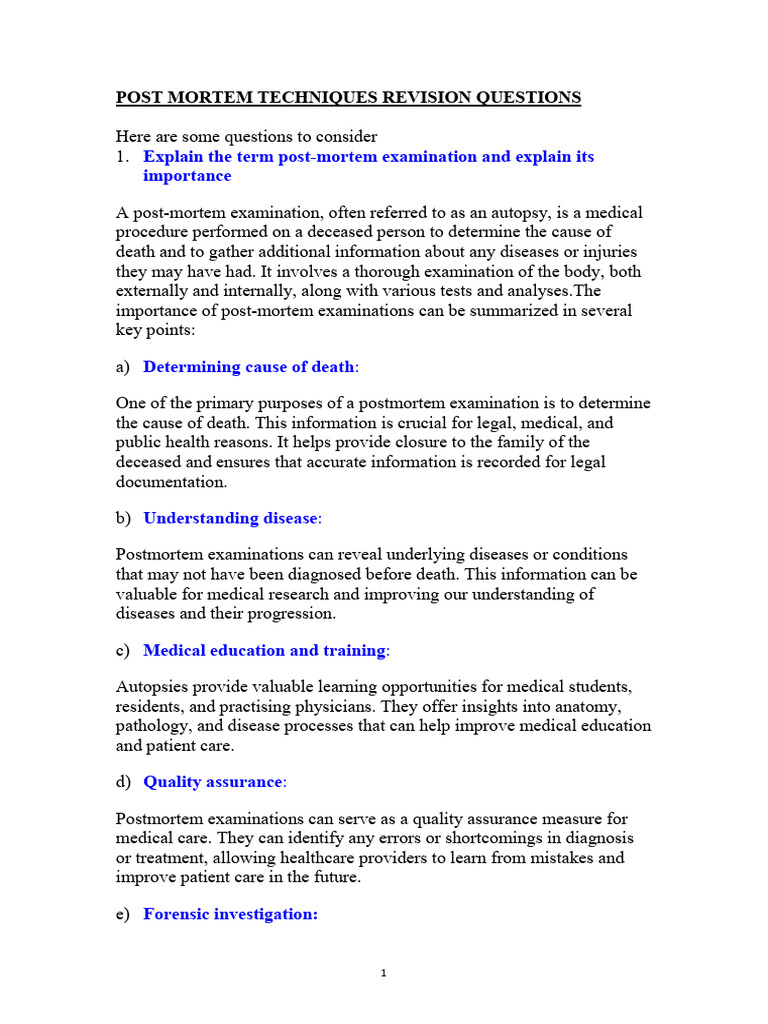Post-mortem techniques and necropsy, often used interchangeably with autopsy, represent a constellation of procedures employed to meticulously examine a deceased organism. This examination aims to ascertain the cause of death, identify any underlying diseases, and gather crucial information for legal, medical, or research purposes. These techniques encompass both external and internal assessments, meticulously documented to provide a comprehensive understanding of the circumstances surrounding death. This detailed investigation can resolve diagnostic uncertainties and refine our understanding of pathological processes.
I. External Examination: The Initial Assessment
The initial stage of any post-mortem examination is a thorough external inspection. This meticulous process involves a detailed visual assessment of the body, noting any identifying features, such as scars, tattoos, or birthmarks. Rigor mortis, livor mortis, and algor mortis are carefully evaluated to estimate the post-mortem interval, or time since death. This estimation, however, is an inexact science, influenced by a multitude of environmental factors. Furthermore, external injuries, such as abrasions, lacerations, contusions, or penetrating wounds, are documented meticulously, including their location, size, and shape. The presence of any foreign objects or materials adhering to the body is also carefully noted and collected for further analysis.
II. Internal Examination: Delving Deeper
Following the external examination, the internal examination, or necropsy, commences. This involves a systematic dissection of the body to visualize and assess the internal organs. The specific techniques employed may vary depending on the suspected cause of death or the focus of the investigation. However, a standard necropsy typically involves the following steps:
A. Incisions and Access: The body is opened through a series of precise incisions, typically a Y-shaped incision extending from the shoulders to the pubic region. The abdominal and thoracic cavities are then opened to expose the internal organs. Careful technique is vital here to avoid inadvertent damage to internal structures.
B. Organ Removal and Examination: Each organ is carefully removed, weighed, and measured. The external surface of each organ is meticulously examined for any abnormalities, such as tumors, cysts, or areas of discoloration. The organ is then sectioned to allow for visualization of the internal parenchyma. Any lesions or abnormalities are documented, photographed, and sampled for microscopic examination.
C. Microscopic Examination (Histopathology): Tissue samples from each organ are fixed in formalin, embedded in paraffin, sectioned thinly, and stained with various dyes to highlight cellular structures. A pathologist then examines these slides under a microscope to identify any microscopic abnormalities, such as inflammation, necrosis, or neoplastic changes. Histopathology is often the cornerstone of establishing a definitive diagnosis.
D. Ancillary Testing: Unveiling Hidden Clues
In addition to the macroscopic and microscopic examination of tissues, a variety of ancillary tests may be performed to further investigate the cause of death. These tests may include:
1. Toxicology: Samples of blood, urine, and other bodily fluids are analyzed to detect the presence of drugs, alcohol, or other toxins. Toxicology is crucial in cases of suspected poisoning or drug overdose.
2. Microbiology: Cultures are taken from various sites to identify any infectious agents that may have contributed to the death. This is particularly important in cases of suspected sepsis or pneumonia.
3. Genetic Testing: In some cases, genetic testing may be performed to identify inherited diseases or genetic predispositions that may have contributed to the death. Furthermore, DNA fingerprinting might be conducted to confirm identification in forensic scenarios.
4. Radiological Imaging: X-rays or CT scans may be performed to identify fractures, foreign objects, or other abnormalities that may not be readily apparent on external examination.
III. Special Post-Mortem Techniques
In certain circumstances, specialized post-mortem techniques may be required to investigate specific types of deaths. These techniques may include:
A. Neuropathology: A specialized examination of the brain and spinal cord to investigate neurological diseases or injuries. This often involves specialized staining techniques and microscopic examination of brain tissue.
B. Forensic Odontology: The examination of teeth and dental records to identify deceased individuals, particularly in cases of mass disasters or when other methods of identification are not possible. Bite mark analysis may also fall under this discipline.
C. Virtual Autopsy (Virtopsy): The use of advanced imaging techniques, such as CT scanning and MRI, to create a three-dimensional reconstruction of the body. This allows for a non-invasive examination of the internal organs and can be particularly useful in cases where a traditional autopsy is not possible or desired.
IV. Documentation and Reporting
Throughout the entire post-mortem process, meticulous documentation is essential. This includes detailed descriptions of all external and internal findings, as well as the results of any ancillary tests. Photographs and diagrams are often used to supplement the written record. The final autopsy report summarizes all of the findings and provides an opinion as to the cause and manner of death. This report is a crucial document for legal, medical, and research purposes.
V. Ethical Considerations
Post-mortem examinations raise a number of ethical considerations. It is important to respect the dignity of the deceased and to obtain consent from the next of kin before performing an autopsy, unless legally mandated. The information obtained from post-mortem examinations should be used responsibly and ethically, with due regard for privacy and confidentiality. Properly performed and documented post-mortem examinations are pivotal for advancing medical knowledge and upholding justice.










Leave a Comment